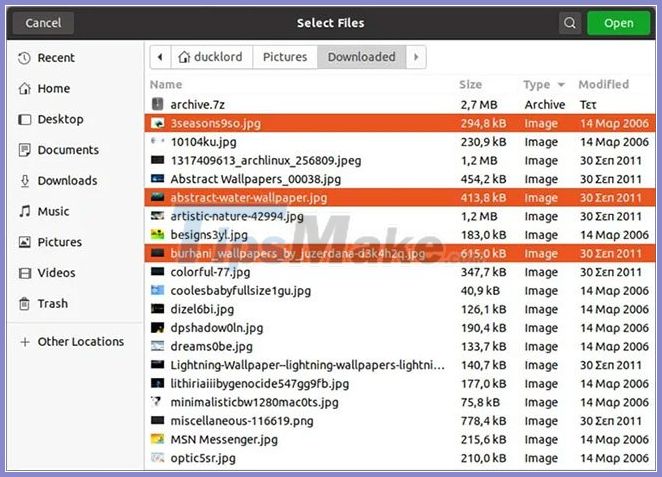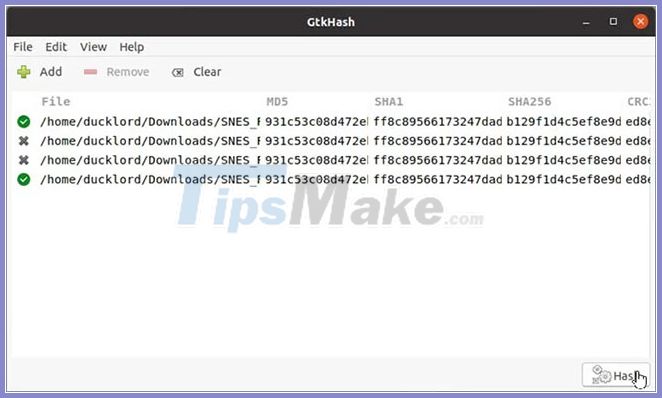How to verify the checksum in Linux
Checksum is a software-derived text string using a hash function. No two checksums are the same. When downloading software from the Internet, one way to verify software integrity is to compare the software's checksum with the checksum provided by the website. If the results match, the software is genuine and has not been tampered with.
While this can be easily done in Terminal, you'll learn here how GtkHash graphical engine checksum can be checked and verified incredibly simple.
1. Install GtkHash
For most Linux distributions, you can find GtkHash in the package manager or Software Center. If you are using Ubuntu or a compatible distro and installed from Terminal, you can install GtkHash with:
sudo apt install gtkhashAs for openSUSE, you will have to add its repository prior to installation.
On Arch and Manjaro:
sudo pacman -S gtkhashOnce installed, find this app among installed apps and run it.
2. Generate hashes
GtkHash's interface is quite simple. To calculate hashes for one or more files, click the Add button at the top left.

Point to the location of the files and select them. You can select multiple files by holding down the Ctrl key while clicking on them. Then, click the Open button at the top right to complete the command.

You can select as many files as you like
The list of GtkHash will be populated with the files you have selected. If you want, you can add more files by repeating the previous step.
Click the Hash button at the bottom right of the GtkHash window to compute the hash for all files in the list.
GtkHash calculates many types of hashes by default and displays them in the columns next to each file.
To copy the file's hash to the clipboard, right-click on the file and choose your preferred hash type from the Copy Digest submenu . Then, paste the copied hash somewhere for future reference.

Alternatively, you can save the hash to a file via File> Save As .
3. Check hash
To check the file's data integrity with GtkHash, choose File> Open and choose the hash file that comes with the main file. The hash file will usually have the extension sha1, md5 or sfv and GtkHash supports all the popular extensions.
Once the file is loaded, click the Hash button in the lower right. GtkHash will compute and compare the file's hash with the reported hash and show you the result. As you can see in the screenshot, there are 2 matches and 2 no matches.

4. More hashing types
GtkHash comes with the most common hashing algorithms enabled, but they are not the only ones it supports. For more, go to Edit> Preferences .
You can choose from over two dozen different hashes, of which you will probably find the one you like.
5. Compare the checksum from the Terminal
If you are in a server environment, the only way to compare the checksum is through Terminal. Fortunately, checking and generating hash files on Terminal is just as easy as using the GUI. Most distributions come with a set of tools for this purpose. Some of the most popular options are:
- md5sum
- shasum
- sha256sum
- sha384sum
- sha512sum
The uses are simple because they work the same way: You enter their name, then the name of the file for which you want to calculate the hash. For example, to compute the SHA-512 hash for the downloaded Arch Linux installation ISO, the example uses:
sha512sum archlinux-2020.05.01-x86_64.isoAbove, sha512sum is the command for the hash algorithm used. After a while of waiting, the SHA-512 hash appeared on the screen.
In the future, you may want to check your files again, so export the results to a file instead of the screen. Hash commands do not provide such functionality as it is only redirected in Linux. By using the > icon after the command and file name, the output of the command will be saved in the file instead of being output to the screen. You can also use sha256sum:
sha256sum archlinux-2020.05.01-x86_64.iso > archlinux-2020.05.01-x86_64.iso.sha256This will output the output to a typical text file that you can test. Inside, you will see the file's hash followed by the file name.

Checking file versus hash only requires you to add switch -c to the command and use the file hash instead of the real file. In other words something like this:
sha256sum -c archlinux-2020.05.01-x86_64.iso.sha256Although verifying the checksum in Linux is easy, it is impractical to check the hash for each file. That's what you should do for sensitive data or Linux ISOs that you have downloaded from the web.
You should read it
- How to fix CMOS Checksum errors
- 6 ways to fix checksum errors in WinRAR
- How to fix Checksum error WinRAR when extracting files
- What is DMG file?
- Check file changes with Marxio File Checksum Verifier
- Instructions to repair game files on different launchers
- How to Verify a GPG Signature
- Viewers of 18+ websites like P*rnhub will have to take a selfie to verify they are 18 years old or older
May be interested
- How to Verify a GPG Signature
 this how-to explains a clear and step-by-step, 1-minute process to verify that a file in your possession was digitally signed by a particular gpg secret key and has been unmodified since the time of signing. to verify your belief that...
this how-to explains a clear and step-by-step, 1-minute process to verify that a file in your possession was digitally signed by a particular gpg secret key and has been unmodified since the time of signing. to verify your belief that... - Instructions for verifying Facebook account identity
 to ensure that your facebook account is not hacked or locked by facebook, users can verify their facebook account identity through their personal documents.
to ensure that your facebook account is not hacked or locked by facebook, users can verify their facebook account identity through their personal documents. - Viewers of 18+ websites like P*rnhub will have to take a selfie to verify they are 18 years old or older
 to ensure compliance with the recently passed online safety act, the uk has proposed that porn site viewers will have to take selfies to verify their age is 18 or over using ai.
to ensure compliance with the recently passed online safety act, the uk has proposed that porn site viewers will have to take selfies to verify their age is 18 or over using ai. - How is Arch Linux different from other Linux versions?
 arch linux is arguably the most misunderstood linux distribution. many people find arch difficult to install and maintain.
arch linux is arguably the most misunderstood linux distribution. many people find arch difficult to install and maintain. - WhatsApp Account Verification Guide
 just like facebook verifies accounts, whatsapp also supports users to verify personal accounts or community accounts.
just like facebook verifies accounts, whatsapp also supports users to verify personal accounts or community accounts. - 14 interesting Linux commands in Terminal
 terminal is a very powerful tool, but it can become 'interesting' through a few bash commands that quantrimang will introduce to you later. let's follow up and find out because some commands are quite useful.
terminal is a very powerful tool, but it can become 'interesting' through a few bash commands that quantrimang will introduce to you later. let's follow up and find out because some commands are quite useful. - Check file changes with Marxio File Checksum Verifier
 in this article, i will show you a free software that can check file changes.
in this article, i will show you a free software that can check file changes. - 18 Interesting Linux Commands in Terminal
 terminal is a very powerful tool, but it can be made 'interesting' through a few bash commands that tipsmake.com will introduce to you below. let's follow and learn because some commands are quite useful.
terminal is a very powerful tool, but it can be made 'interesting' through a few bash commands that tipsmake.com will introduce to you below. let's follow and learn because some commands are quite useful. - Compare the most popular Linux distributions today
 it can be said that linux is not a complete operating system, it is just a kernel operating system, which is the foundation for developing other operating systems.
it can be said that linux is not a complete operating system, it is just a kernel operating system, which is the foundation for developing other operating systems. - 7 best Linux distributions based on Red Hat
 red hat became the largest open source company in the world before it was acquired by ibm, and red hat enterprise linux was its main product.
red hat became the largest open source company in the world before it was acquired by ibm, and red hat enterprise linux was its main product.










 Fix 'No Application Found' error in Ubuntu Software
Fix 'No Application Found' error in Ubuntu Software Fix WiFi not working on Ubuntu
Fix WiFi not working on Ubuntu How to record system audio on Linux
How to record system audio on Linux How to install Deepin desktop environment on Ubuntu
How to install Deepin desktop environment on Ubuntu How to change screen resolution in Ubuntu
How to change screen resolution in Ubuntu Is Linux the operating system or the kernel?
Is Linux the operating system or the kernel?